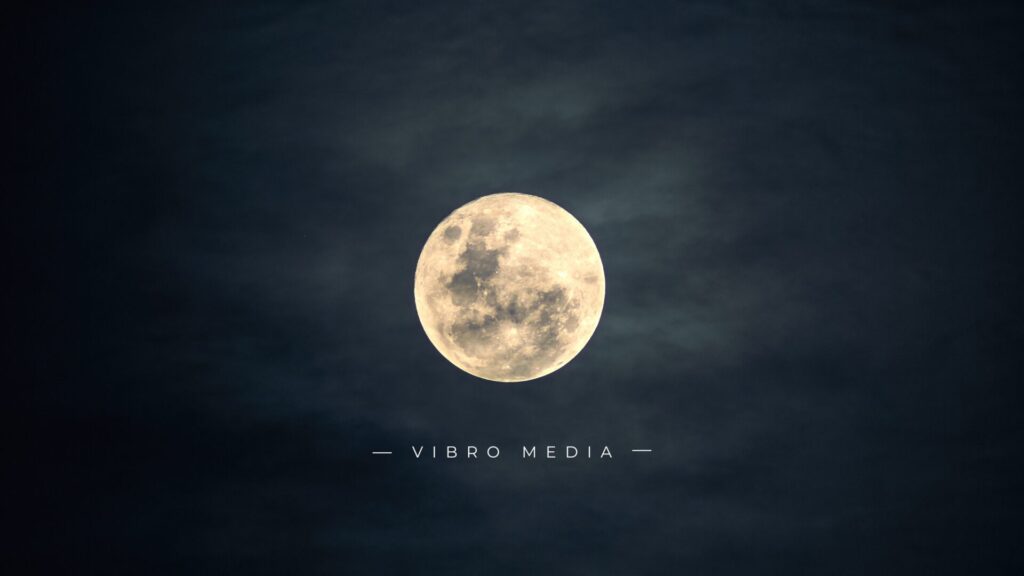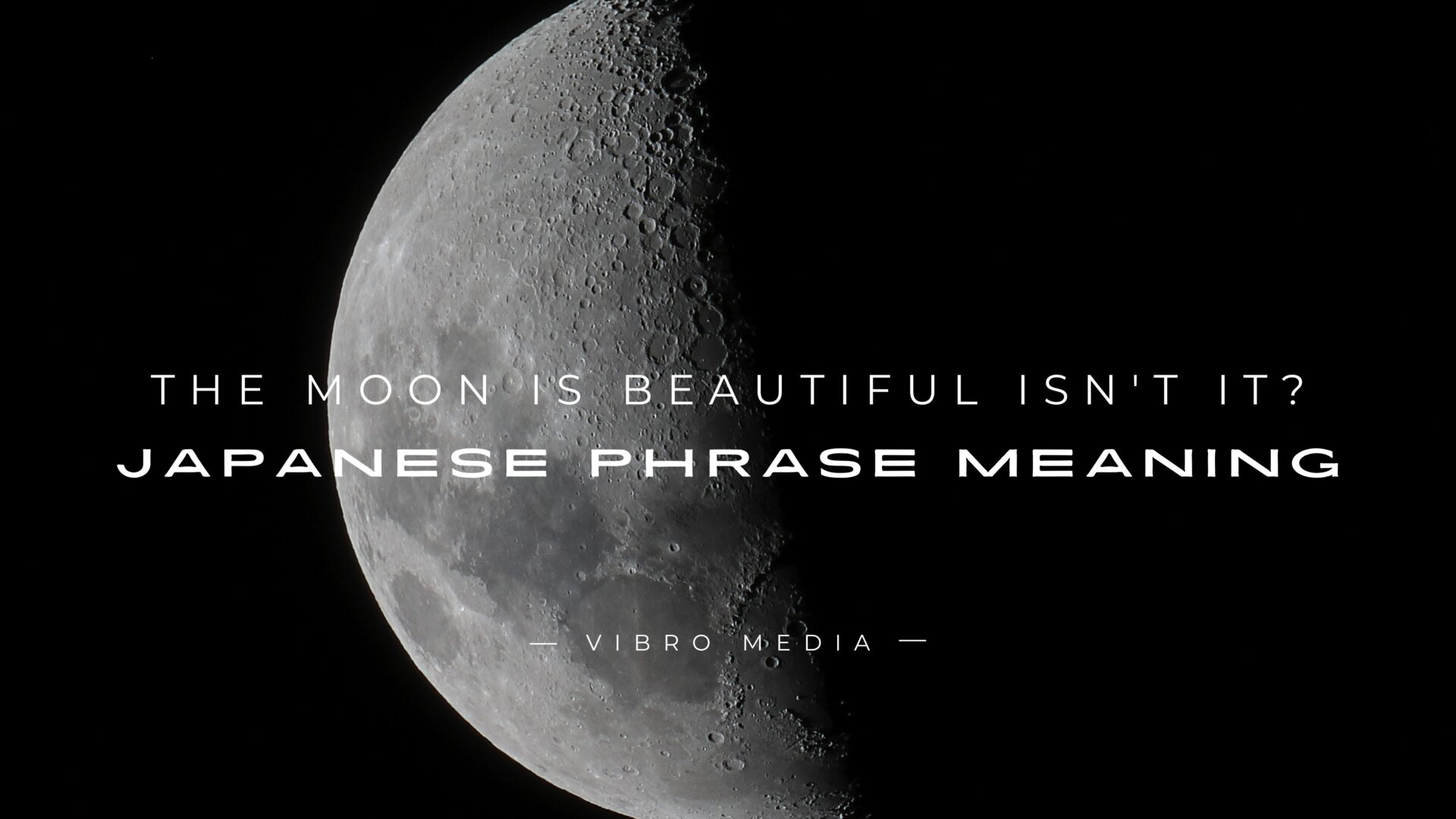Have you ever heard the phrase “The moon is beautiful, isn’t it?” and wondered why it feels so poetic? On the surface, it sounds like a simple observation about the night sky. However, in Japanese culture, these words have a far deeper meaning. What if I told you this unassuming sentence is a subtle and romantic way to say, “I love you”?
Japanese language and culture often prioritize indirectness, subtlety, and emotional nuance. Instead of directly stating their feelings, Japanese speakers sometimes wrap them in layers of poetic language. This phrase is one of the most beautiful examples of that subtlety. Join me as we explore this timeless expression’s origins, hidden meanings, and cultural significance.

Understanding the Phrase: “The Moon is Beautiful, Isn’t It?”
At face value, “The moon is beautiful, isn’t it?” (月が綺麗ですね, “Tsuki ga kirei desu ne”) simply seems like a comment on a beautiful night. However, in Japanese, it is much more than just an appreciation of the moon’s glow. In reality, it’s a veiled expression of love.
In Japanese, it’s not common to directly say “I love you” (“Aishiteru”). Instead, people often communicate feelings of affection in more reserved, poetic ways. When someone says, “The moon is beautiful, isn’t it?” they are commenting on the moon’s beauty and using the moment to subtly confess their love. This phrase has become a beloved and romantic way of saying, “I love you,” without uttering the words.
The Hidden Meaning Behind the Phrase
So, why not just say, “I love you” directly? In Japanese culture, outright declarations of love can feel too direct, blunt, or uncomfortable. This phrase, however, allows feelings to be shared in a more delicate, respectful, and understated manner. In this case, the moon becomes a metaphor for the person’s feelings, allowing them to express their love without saying it outright.
When someone tells you, “The moon is beautiful, isn’t it?” they invite you to understand the deeper emotion behind their words. They are sharing an intimate moment with you, allowing the beauty of nature to symbolize the beauty of their feelings for you.
Origins of the Phrase
The phrase is widely believed to have originated from the celebrated Japanese novelist Natsume Sōseki, a literary giant of the Meiji Era (1868–1912). The story goes that Sōseki was teaching English, and one of his students translated “I love you” directly into Japanese as “Aishiteru.” However, Sōseki, known for his deep understanding of Japanese culture and the nuances of language, found this too literal. He suggested a more poetic translation: “The moon is beautiful, isn’t it?”
While it may seem far removed from the original “I love you,” this translation captures how Japanese people express their emotions—indirectly, thoughtfully, and elegantly.
Cultural Importance of the Moon in Japan
The moon has long held a special place in Japanese culture. It is seen as a symbol of beauty, change, and time, all deeply connected to the Japanese appreciation of nature. The moon’s soft glow is often associated with quiet reflection and admiration, making it a perfect metaphor for love.
During the Tsukimi (moon-viewing) festival, a tradition of over a thousand years, people gather to appreciate the full moon. This festival celebrates the moon, the changing seasons, and the fleeting beauty of life—concepts that resonate deeply in Japanese culture. The moon’s beauty is seen as transient, much like the delicate cherry blossoms, which adds to its emotional and spiritual significance.
Why the Moon?
Why was the moon chosen to symbolize such deep emotions? The moon is universally associated with beauty, romance, and longing. Its presence in the night sky is constant yet ever-changing, much like the feelings of love. Lovers, separated by distance, can gaze upon the same moon, feeling connected despite being apart. This idea of shared experience through the moonlight has made it a symbol of love in various cultures worldwide, including Japan.
In Japan, the moon has inspired countless poems, songs, and works of art, always representing something beyond its physical appearance. It is not just a celestial body but a mirror for human emotions, including love, loneliness, and desire. Therefore, the moon would serve as the backdrop for a subtle confession of love.
The Power of Subtlety in the Japanese Language
Subtlety is a key aspect of communication in Japan, especially regarding love. In contrast to more direct cultures, where emotions are often expressed openly, Japanese people communicate their feelings more nuancedly. This is especially true for romantic relationships.
Directly saying “I love you” can feel awkward or even too intense in Japan, particularly in everyday conversations. Instead, phrases like “The moon is beautiful, isn’t it?” allow for an expression of love that feels more natural and poetic. This subtlety isn’t about being vague or withholding feelings—it’s about expressing them in a way that feels intimate and profound without overwhelming the listener.
Natsume Sōseki’s Influence on Modern Language
Natsume Sōseki’s influence extends far beyond this single phrase. He was one of Japan’s greatest novelists, and his works often explore themes of human relationships, isolation, and the complexity of emotions. His sensitivity to language and culture helped shape modern Japanese literature, and his legacy continues to impact how people express themselves today.
“The moon is beautiful, isn’t it?” is a prime example of how Sōseki’s works have left a lasting mark on Japanese culture. The phrase still resonates with readers and romantics alike, serving as a reminder of the power of words to convey deep emotions without being overly explicit.
The Phrase in Contemporary Japan
So, is this phrase still used today? The answer is yes, though not as frequently in everyday conversation. It has, however, retained its charm and continues to be referenced in literature, movies, and even anime. It’s a phrase people recognize, even if they don’t often use it.
The phrase may feel old-fashioned for younger generations, but it still carries an undeniable romantic appeal. Whether it’s used in moments of deep reflection or whispered during a quiet evening walk, “The moon is beautiful, isn’t it?” remains a powerful expression of love.
Other Japanese Phrases of Endearment
Of course, “The moon is beautiful, isn’t it?” isn’t the only way to express affection in Japanese. There are more direct phrases, like “Suki desu” (好きです), which means “I like you,” or “Daisuki desu” (大好きです), which means “I really like you” or “I love you.” These phrases are more commonly used today, especially among younger people.
However, something uniquely charming about the indirectness of “The moon is beautiful, isn’t it?” sets it apart from these more straightforward expressions. The phrase feels timeless, like a secret message only those in the know will understand.
Comparing Love Phrases in Different Cultures
When comparing Japanese expressions of love with those from other cultures, the difference in directness becomes immediately clear. In many Western cultures, people say “I love you” without hesitation. It’s a phrase used frequently in romantic relationships, family settings, and even friendships.
In contrast, Japanese culture places a higher value on restraint and subtlety. Love is communicated through actions, gestures, and indirect language, like “The moon is beautiful, isn’t it?”. This difference reflects broader cultural values about relationships, communication, and emotional expression.
How to Use “The Moon is Beautiful, Isn’t It?” in Conversation
I would like to know when to use this phrase. It’s best reserved for quiet, reflective moments, particularly with someone you care deeply about. Imagine a peaceful evening, perhaps during a walk under the stars, with the moon shining brightly. That’s the perfect time to say, “The moon is beautiful, isn’t it?”
You would not say it casually or in a crowded, noisy environment. It’s a phrase that carries weight and is meant to be shared in moments of quiet intimacy. And if someone says it to you, how should you respond? A simple smile, a nod, or a quiet “Yes, it really is” will do. The beauty of the phrase is that it doesn’t require an elaborate response—the emotion is already conveyed through the shared experience.
The Phrase in Popular Culture
The phrase has found its way into various aspects of Japanese popular culture. It appears in books, films, and TV shows, often in romantic or dramatic scenes. For anime fans, it’s not uncommon to see the phrase pop up as a subtle love confession. The continued presence of the phrase in modern media helps keep its romantic and cultural significance alive.
Globally, the phrase has also attracted the attention of those interested in the Japanese language and culture. Its poetic nature has a universal appeal and resonates with anyone who appreciates the beauty of indirect communication.
Learning the Art of Indirect Communication
For those learning Japanese or trying to understand its culture, mastering the art of indirect communication can be a rewarding challenge. Phrases like “The moon is beautiful, isn’t it?” offer a glimpse into the subtlety and elegance that define much of the Japanese language and culture.
Indirect communication doesn’t just apply to love—many Japanese phrases are designed to express feelings or intentions in gentle and understated ways. This approach to language encourages reflection and creates deeper connections between people, making conversations more meaningful.
Conclusion
In conclusion, the phrase “The Moon is Beautiful, Isn’t It?” holds a timeless, poetic charm that goes beyond its literal meaning. It’s a subtle yet profound way to express deep affection, allowing people to convey feelings of love without explicitly stating them. Whether you’re a fan of Japanese culture or simply intrigued by the nuances of language, this expression is a beautiful reminder of how love can be communicated in more ways than one. And if you’re ever faced with a heartfelt confession,
You might want to explore:
200+ Best Ways to Respond to a Crush Confession
FAQs
Q. What does “The Moon is Beautiful, Isn’t It?” mean in Japanese culture?
This phrase is a poetic, indirect way of expressing love in Japanese culture. Instead of directly saying, “I love you,” the speaker uses the moon’s beauty as a metaphor for their feelings.
Q. Who first said, “The Moon is Beautiful, Isn’t It?”
The phrase is attributed to Natsume Sōseki, a famous Japanese novelist from the Meiji Era, who suggested it as a more poetic translation of “I love you.”
Q. Is the phrase still used in Japan today?
While it may not be used as frequently in daily conversation, it still holds significance in literature, pop culture, and romantic moments.
Q. How do I respond if someone says, “The Moon is Beautiful, Isn’t It?” to me?
You can respond with a simple smile or say, “Yes, it really is,” acknowledging the romantic or emotional significance behind the words.
Q. Are there other similar phrases in Japanese for expressing love?
Yes, phrases like “Suki desu” (I like you) and “Daisuki desu” (I like you) are more direct expressions of affection, though they lack the poetic subtlety of the moon phrase.











1 thought on “The Moon is Beautiful Isn’t It? : Japanese Phrase Meaning”